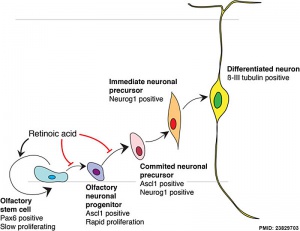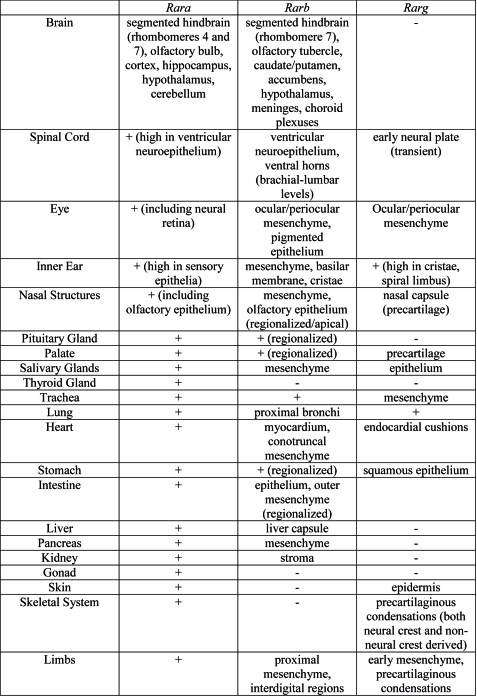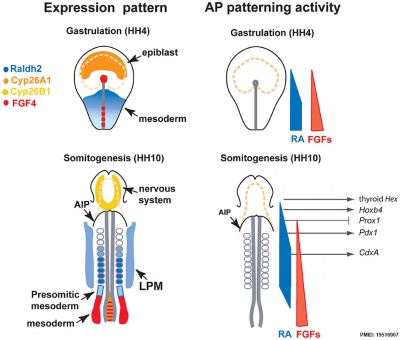Developmental Signals - Retinoic acid: Difference between revisions
mNo edit summary |
mNo edit summary |
||
| Line 4: | Line 4: | ||
[[File:Retinoid acid model in olfactory development.jpg|thumb|300px|Model for retinoid acid in olfactory development<ref name=PMID23829703><pubmed>23829703</pubmed>| [http://www.neuraldevelopment.com/content/8/1/13 Neural Dev.]</ref>]] | [[File:Retinoid acid model in olfactory development.jpg|thumb|300px|Model for retinoid acid in olfactory development<ref name=PMID23829703><pubmed>23829703</pubmed>| [http://www.neuraldevelopment.com/content/8/1/13 Neural Dev.]</ref>]] | ||
All-trans retinoic acid (atRA) is the transcriptionally active product of vitamin A and is known to play many roles in embryo development. | All-trans retinoic acid (atRA) is the transcriptionally active product of vitamin A and is known to play many roles in regulating embryo development. | ||
The compound has been used extensively postnatally in therapeutic treatments, for example in skin disease. Its developmental signalling role is a factor for its known teratogenic effects<ref name=PMID10331090><pubmed>10331090</pubmed></ref><ref name=PMID11375780><pubmed>11375780</pubmed></ref> from maternal to conceptus transfer. | The compound has been used extensively postnatally in therapeutic treatments, for example in skin disease. Its developmental signalling role is a factor for its known teratogenic effects<ref name=PMID10331090><pubmed>10331090</pubmed></ref><ref name=PMID11375780><pubmed>11375780</pubmed></ref> from maternal to conceptus transfer. | ||
Revision as of 10:02, 13 December 2016
| Embryology - 2 May 2024 |
|---|
| Google Translate - select your language from the list shown below (this will open a new external page) |
|
العربية | català | 中文 | 中國傳統的 | français | Deutsche | עִברִית | हिंदी | bahasa Indonesia | italiano | 日本語 | 한국어 | မြန်မာ | Pilipino | Polskie | português | ਪੰਜਾਬੀ ਦੇ | Română | русский | Español | Swahili | Svensk | ไทย | Türkçe | اردو | ייִדיש | Tiếng Việt These external translations are automated and may not be accurate. (More? About Translations) |
Introduction

All-trans retinoic acid (atRA) is the transcriptionally active product of vitamin A and is known to play many roles in regulating embryo development.
The compound has been used extensively postnatally in therapeutic treatments, for example in skin disease. Its developmental signalling role is a factor for its known teratogenic effects[2][3] from maternal to conceptus transfer.
| Factor Links: AMH | hCG | BMP | sonic hedgehog | bHLH | HOX | FGF | FOX | Hippo | LIM | Nanog | NGF | Nodal | Notch | PAX | retinoic acid | SIX | Slit2/Robo1 | SOX | TBX | TGF-beta | VEGF | WNT | Category:Molecular |
| Category:Retinoic acid | Abnormal Development
Some Recent Findings
|
| More recent papers |
|---|
|
This table allows an automated computer search of the external PubMed database using the listed "Search term" text link.
More? References | Discussion Page | Journal Searches | 2019 References | 2020 References Search term: Embryo Retinoic acid | Images <pubmed limit=5>Embryo Retinoic acid</pubmed> |
Organ Expression
Summary of Rar gene expression patterns in mouse developing organ systems.[6]
Endoderm
Chicken antero-posterior endoderm patterning[7]
- Links: Endoderm | Chicken Development
Fetal Gonad
Immunohistochemical localisation of retinoid receptor expression in the human fetal gonad[8]
Neural
Model retinoic acid extracellular signal-regulated kinase and Wnt pathway interactions[9]
RA Is Not Required for Radial Expansion of the Embryonic Cortex
References
- ↑ <pubmed>23829703</pubmed>| Neural Dev.
- ↑ <pubmed>10331090</pubmed>
- ↑ <pubmed>11375780</pubmed>
- ↑ <pubmed>25558812</pubmed>
- ↑ <pubmed>23563268</pubmed>
- ↑ <pubmed>19471585</pubmed>
- ↑ 19516907</pubmed>| PLoS One.
- ↑ Childs AJ, Cowan G, Kinnell HL, Anderson RA, Saunders PTK (2011) Retinoic Acid Signalling and the Control of Meiotic Entry in the Human Fetal Gonad. PLoS ONE 6(6): e20249. PMID 21674038 | PLoS One
- ↑ <pubmed>19642999</pubmed>
Articles
<pubmed>21673209</pubmed>| Can Fam Physician
Search Pubmed
Search Bookshelf Retinoic acid
Search Pubmed Now: Retinoic acid
Glossary Links
- Glossary: A | B | C | D | E | F | G | H | I | J | K | L | M | N | O | P | Q | R | S | T | U | V | W | X | Y | Z | Numbers | Symbols | Term Link
Cite this page: Hill, M.A. (2024, May 2) Embryology Developmental Signals - Retinoic acid. Retrieved from https://embryology.med.unsw.edu.au/embryology/index.php/Developmental_Signals_-_Retinoic_acid
- © Dr Mark Hill 2024, UNSW Embryology ISBN: 978 0 7334 2609 4 - UNSW CRICOS Provider Code No. 00098G






